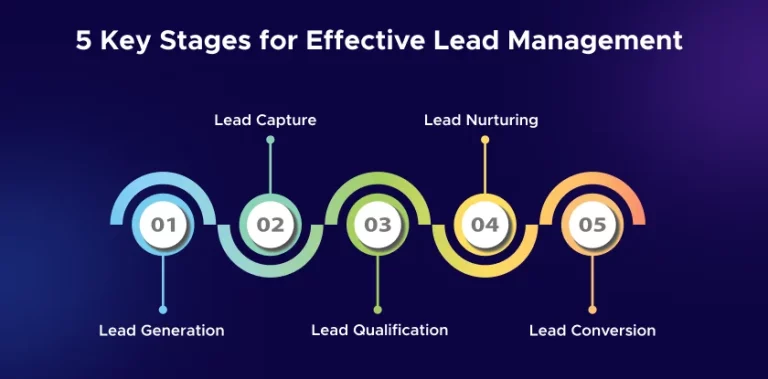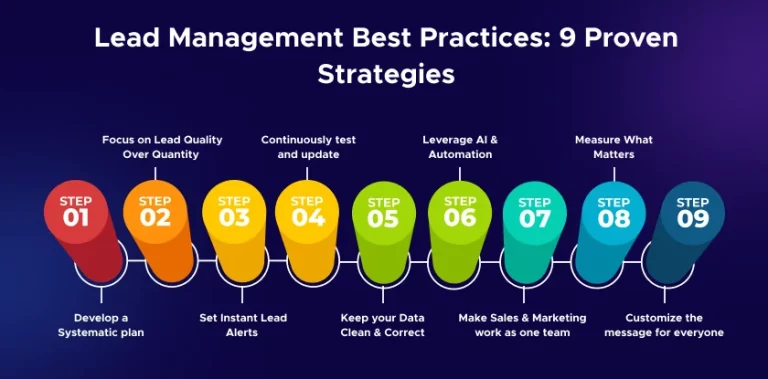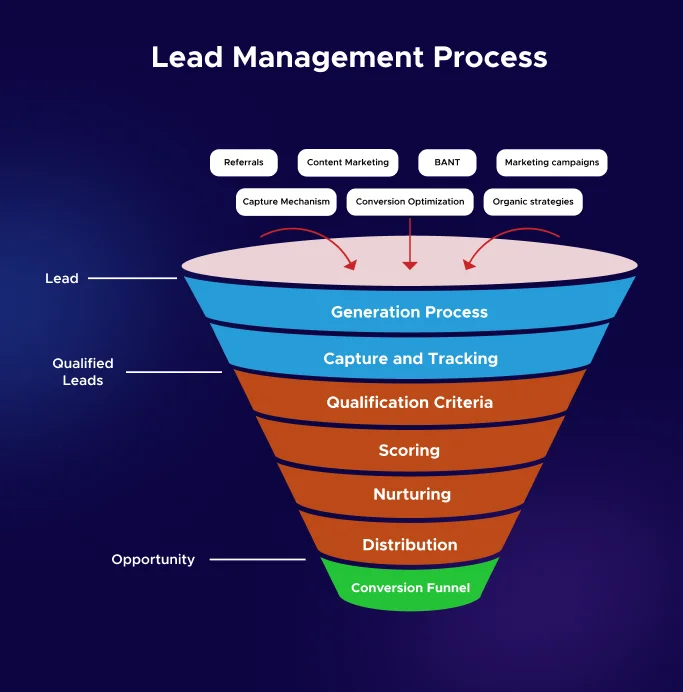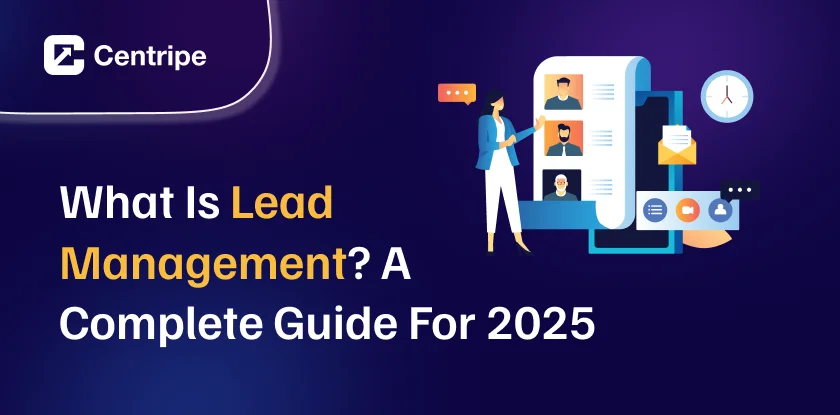If you are a business owner, you may have experience…
‘‘You are getting leads, but they are not converting into sales? ’’.
The problem? Poor lead management.
And, you are not alone.
In fact, a study by Harvard Business Review found that 79% of leads never turn into sales. Why?
Because companies are too slow to respond and don’t have a proper system to manage their leads. That’s why good lead management matters.
This guide will teach you what exactly lead management is, why it is important in businesses, and how to implement proven steps that most successful firms adopt to turn 50 % more leads into customers.
Understanding the Lead Management Definition
Lead management is the process of managing and tracking potential customers in their buying journey. It involves using correct strategies and tools to attract valuable leads and turn them into loyal customers.
And honestly, it doesn’t end there, it goes on even after they have become a customer.
At its core, lead management helps you answer 3 critical questions:
- Who are your potential customers?
- Where are they in their buying journey?
- How can you best guide them toward a purchase decision? (Without being that pushy salesperson everyone avoids)
Lead vs. Prospect: A Clear Comparison
People often see the words ‘Leads’ and ‘Prospects’ as the same. But there is a major difference between them. Let’s find out that.
The Real Difference Between Leads and Prospects:
| Terms | Leads | Prospects |
|---|---|---|
| What it means | A lead is anyone who’s given you their contact information or shown initial interest. | A prospect is a qualified lead who fits your ideal customer profile and could buy your product. |
| Why it matters | You have their attention, but they are not ready to buy your product yet. | These are the ones to focus on; they’re more likely to become buyers. |
5 Key Stages for Effective Lead Management

The lead management process has five simple steps that help turn interested people into paying customers. Each step moves through the sales journey, one stage at a time.
Stage 1: Lead Generation
This is the first stage where it all begins. You collect prospect information through forms, landing pages, events, or integrations.
Stage 2: Lead Capture
As soon as one shows interest in what you are offering, your system records the way the lead engages with your brand. Like this, you get to know what they want and how serious they are.
Stage 3: Lead Qualification
This stage helps you spot the potential buyers. As not all leads are interested in buying your product, some people are simply browsing. It helps your team to target the correct individuals.
Stage 4: Lead Nurturing
During this phase, you remain in contact with the leads by sharing useful tips, offers, or updates. This step involves building trust until they’re ready to buy.
Stage 5: Lead Conversion
Lastly, it’s time to send the lead to the right sales rep, someone who can handle it best.
Bonus Advice: Just because a lead becomes a customer (stage 4) doesn’t mean your job is done. To turn one-time buyers into loyal customers, you need to keep building the relationship even after the sale.
Why Is Lead Management Important for B2B Success?
Lead management is the heart of the sales process. It helps in finding the right prospect for your business and guiding them step by step until they are ready to buy.
Not just this, there are many more reasons why this matters for B2B success.
Here’s why:
1. Maximizes Marketing ROI:
When more than half of marketers spend 50%+ of their budget on lead generation, you don’t want to waste it. This is where good lead management helps you focus on the right people so that every rupee or dollar counts.
2. Improves Sales Efficiency:
Do you know Sales teams waste 67% of their time on leads that go nowhere? This is where Lead management saves time by finding those who are interested.
3. Enhances Customer Experience:
As per McKinsey, people are 40% more likely to buy when things feel personal.
Lead management helps you remember small details, so every message feels like it was just made for them.
4. Provides Competitive Advantage:
While competitors chase every lead, you’re focusing on high-value opportunities. Result? This means quicker sales and happier clients.
5. Creates Predictable Revenue:
Taking random decisions won’t let your business grow. Lead management gives you a clear system that brings in the right leads and turns them into regular sales.
Lead Management Best Practices: 9 Proven Strategies

Do you want more of your leads to turn into loyal customers? Here are 9 tested lead generation strategies to manage them better and grow your sales.
1. Develop a Systematic plan:
Document everything. Have correct documentation of what constitutes a lead, when to pass to sales, follow-up schedules, and what happens when things go wrong.
2. Set Instant Lead Alerts:
By setting an instant lead alert, you can save valuable customers and increase the chance of closing the deal faster. When someone checks your pricing page, requests a demo, or shares your content, you’ll get a notification and act faster to close the deal.
3. Keep your Data Clean & Correct:
One of the most important strategies is keeping your data clean. A clean database helps you remove duplicates, fill in missing info, and keep everything accurate. Not only this, but it also automates enriching the contact information, standard fields, auditing, etc.
4. Make Sales and Marketing work as one team:
The marketing and sales team can not achieve their target if they are not well coordinated. So, begin by setting clear rules. Communicate regularly, share data properly, and give feedback that helps them improve.
5. Customize the message for everyone:
Work on customizing the content by industry and behavior. Use AI here, and let it suggest which strategy works best, focus on key accounts, and reach out at just the perfect time.
6. Focus on Lead Quality Over Quantity:
Don’t focus on more leads; instead, focus on the right ones. By clearly defining your target customers, collecting data progressively, and using intent signals.
7. Continuously test and update:
This is one of the powerful strategies to keep testing new things. Such as different messages or offers, changing how often you follow up, and improving how you pick good leads.
8. Leverage AI and Automation:
With the use of automation, eliminate repetitive tasks. Gain insights that help you make better decisions, predict the scoring, smart sequences, etc.
9. Measure What Matters:
To see the growth of business, it is important to focus on metrics. See how many leads turn into real sales, where your biggest deals come from, how long it takes to close a deal, and how much each lead costs you.
The Lead Management Process: A Step-by-Step Framework

Here’s the 7-step framework that high-performing sales and marketing teams swear by:
Step 1: Lead generation process
Everything starts with attracting potential customers. These days, you need to use different ways to reach people. Let’s dive into those different ways:
Content marketing helps you build trust among people by sharing helpful things so that people read or watch them and learn about your business. It includes:
- Blog posts that actually solve customer problems
- Whitepapers and industry reports
- Webinars that don’t put people to sleep
- Case studies that tell real stories
Digital advertising means paying to show your business on the Internet, such as Google, Facebook, Instagram, etc. It helps more people to see you, even if they have never heard of you before.
- Search engine marketing
- Social media ads that don’t feel like ads
- Display and retargeting campaigns
- LinkedIn sponsored content
Organic strategies are about growing without paying for ads. You use SEO, post on social media, or get others to talk about you, to let everyone know about you.
- SEO that plays the long game
- Engaging on social media
- Building Communities That Care
- Partner and referral programs that work
Pro Tip: I’ve learned this the hard way, focus on quality over quantity. It’s way better to generate 100 highly targeted leads than 1,000 random contacts who’ll never buy.
Step 2: Lead capture and tracking
Once you’ve got their attention, you need systems to collect and monitor their info:
Capture Mechanisms: These are tools that collect lead information to get people into your system.
- Landing pages with offers they can’t refuse.
- Progressive profiling forms.
- Chatbots that actually help.
- Event registration systems.
- Social media lead forms.
Tracking Activities: This shows what your leads are doing. Such as:
- What pages are they checking out?
- Which emails are they opening?
- What content they’re downloading?
- If they’ve requested a demo.
- How they’re engaging on social.
Modern CRMs handle this automatically, giving you the full picture of each lead’s journey.
Step 3: Lead qualification criteria
Here’s where things get interesting. Not every lead deserves the same attention, harsh but true. But there are methods that will help you see which leads are worth investing your time.
| Framework | Best For | Key Focus | Complexity |
|---|---|---|---|
| BANT | Traditional B2B sales | Budget Confirmation | Low |
| CHAMP | Solution Selling | Customer challenges | Medium |
| MEDDIC | Enterprise sales | Decision process | High |
- BANT: It stands for Budget, Authority, Need, and Timeline. It helps you know if someone is really ready to buy. You get the answers to: Do they have money? Are they the ones who can decide? Do they need what you’re selling? And when do they plan to buy?
- CHAMP: It helps you understand the customer’s problem. You get the answers to: What trouble are they facing? Who decides what to buy? Do they have money for it? And how quickly do they want to fix the problem?
- MEDDIC: It helps you find out what success means to them. You get the answers to: Who controls the money? How do they choose between options? How do they make buying decisions? What problem is pushing them to act fast? And if someone inside their team supports you?
Step 4: Lead scoring
It means giving each lead a score based on what they do and who they are. This helps your team focus on the leads that are most likely to buy first.
| Based on | Demographic Scoring | Based on | Behavioral Scoring |
|---|---|---|---|
| Industry match | +20 points | Requested demo | +30 points |
| Company size fit | +15 points | Downloaded pricing | +25 points |
| Job title relevance | +10 points | Visited 5+ pages | +10 points |
| Geographic location | +5 points | Opened 3+ emails | +5 points |
| Total | 50 | 70 |
For Example:
Like in the above example, you can see behavioural has a higher score, showing these leads are more ready to buy.
Step 5: Lead Nurturing
Here’s a stat that blows my mind: 50% of leads aren’t ready to buy right away. That’s why you need to stay in touch so that when they are ready to buy, they choose you. You can stay in their mind by:
Email Nurturing Campaigns: Send simple emails at the right time to help leads move closer to buying.
- A welcome series that actually welcomes
- Educational content that teaches
- Product-focused workflows
- Re-engagement campaigns for the quiet ones
Multi-Channel Nurturing: Reach your leads through emails, social media, calls, and ads, wherever they spend time.
- Retargeting ads with helpful content
- Social media that’s actually social
- Personalized direct mail
- SMS or WhatsApp when appropriate
Step 6: Lead Distribution
Speed helps you win deals. Even studies show responding within five minutes increases conversions by 900%. Here are the methods that will help you crack it.
Distribution method:
- Round-robin for fairness
- Territory-based relationships
- Skill-matching for expertise
- Account-based for strategic accounts
Automation Rules:
- High scorers go to senior reps
- Enterprise leads to account execs
- SMBs to inside sales
- International to regional teams
Step 7: Lead Conversion funnel and Post-Sale Management
The journey doesn’t end with just closing the deal. Smart companies know this, that why they keep building trust and help customers even after the sale. Then what to do:
Conversion Optimization: It’s the final push that you should give.
- Make it easier for leads to take action
- Give them reason to say ‘yes’ to your product
- Build trust through Social proof
- Guarantees that reduce risk
Post-Sale Relationship Building:
- Help the customer start using your product easily
- Regular check-ins that add value to keep them engaged
- Upsell campaigns that make sense
- Turn happy customers into promoters
How Much Does Lead Management Software Cost?
The pricing of software depends on the features you are looking for and the size of your company. Therefore, we have listed the approximate pricing based on the company’s size.
- Basic tools: Works well for small businesses, usually costs $50-200/user/month
- Mid-market solution: Works well for growing businesses, usually costs $200-800/user/month
- Enterprise platforms: Works well for advanced features, usually costs $800-2000+/user/month
Additional cost:
- Implementation Charges: One-time setup charges, usually 10-50% of your annual fees.
- Training and support: Often included, but sometimes charged additional fees depending on the vendor.
Lead Management vs. CRM: What’s the Difference?
This confusion comes up all the time. Here’s the breakdown:
| Features | Lead management | CRM |
|---|---|---|
| Focus | Pre-customer journey | Entire customer lifecycle |
| Key Activities | Qualification and nurturing | Includes deals, accounts, and support |
| Primary Goal | Marketing-sales bridge | Manages Sales and service relationships |
| Approach | Process-oriented | Relationship-oriented |
Think of lead management as a crucial component of your broader CRM strategy; they work together, not separately.
Common Lead Management Challenges and Solutions
Challenge 1: Marketing and sales often blame each other when leads don’t convert.
Solution to fix it: Set simple rules for when and how leads move from marketing to sales. This avoids confusion and helps both teams work better together.
Challenge 2: Leads lose interest because of late responses.
Solution to fix it: Automate immediate responses and real-time routing for hot leads to boost conversions fast.
Challenge 3: Not having a clear understanding of what is working and what may not.
Solution to fix it: Build single dashboards to avoid confusion, showing the full journey from lead to customer.
Challenge 4: Inconsistent follow-up, causing lost leads.
Solution to fix it: With automatic follow-up tasks to get alerts and let managers track progress smoothly.
Challenge 5: Unorganized data leads to bad decisions and wasted time.
Solution to fix it: Use simple rules, smart tools, and regular cleanups to keep data accurate and useful.
The Future of Lead Management
Lead management is entering a smarter, more connected future.
AI bots can now talk to leads like real people, answering questions and booking meetings on the spot. Even better, you can also spot interested buyers even before they out to you.
Here’s what the future of lead management looks like, and why it matters.
- Intent Data: No more need to wait for leads to come to you. With intent data, you can now easily spot buyers researching your company.
- Conversational AI: With the help of smart chatbots, you can now easily handle real conversations. By answering difficult conversations and booking meetings anytime.
- Account-Based management: You now easily target the entire buying team by aligning messages and moving them together towards a single decision.
- Predictive Analytics: With AI, you can now predict which leads will convert into customers and when they are likely to close.
- Revenue Operatins: Get teams to work together across sales, marketing, and support to grow revenue faster and more smoothly.
Case Study of Teligistics, A Telecom Company

Teligistics, a telecom company, wanted more good leads, but their internal team couldn’t keep up. So, they teamed up with Intelemark, a lead generation agency.
In just a few months, they saw a 400% jump in qualified leads, without hiring extra staff. This big boost helped them fill their sales pipeline faster and grow smoothly while keeping costs low.
Wrapping Up
If you’ve made it this far, one thing is clear, you care about turning leads into real business. And that’s exactly what lead management helps you do.
When you follow the right steps, things start to click.
More people will say yes, sales will move faster, your team will work smoothly, and customers will stick with you for longer.
The real question is not ‘Do I need lead management?’.
It’s ‘’How many more good leads am I willing to lose?’’
So choose a simple system that works and grow your business with a plan and not with luck.
